 Queen Street sign (2021). Rachel Sonius. Word on the street image collection.
Queen Street sign (2021). Rachel Sonius. Word on the street image collection.
 Queen Street sign (2021). Rachel Sonius. Word on the street image collection.
Queen Street sign (2021). Rachel Sonius. Word on the street image collection.
Queen Street was named after Queen Victoria, the reigning monarch at the time New Plymouth was founded. Victoria was crowned when she was just 18, survived at least eight assassination attempts and was the first monarch to ride a train.
Her Majesty’s Diamond Jubilee (the so-called Record Reign) was celebrated on Tuesday 22 June 1897 and festivities were held across the British Empire. New Plymouth residents were given a public holiday and festooned the streets with flags and bunting. An enormous procession, featuring thousands of schoolchildren, sports clubs, military veterans, bands and choirs paraded through town, including along Queen Street itself, to Pukekura Park. The town then “jubilated” well into the night, with elaborate coloured gas illuminations lighting up shops and buildings.
Queen Street is just one of more than sixty other Queen Streets around the country and home to several notable heritage structures.
The Govett-Brewster Art Gallery opened in 1970 but started life as New Plymouth's first Primitive Methodist Church. Built in 1862, it was replaced with a larger house of worship in 1904 that became the People’s Picture Theatre in 1916. After a name change to the Regent in 1930, the cinema operated until the 1960s before being transformed into the contemporary gallery.
The White Hart Hotel was built on the corner of Queen and Devon in 1887 by owner Horatio Hammond, on the site of a house once used as a hospital during the Taranaki Wars. The White Hart’s distinctive balconies and iconic stag statue were added in 1901.
The old Taranaki Club opened in 1921 on the corner of Queen and St Aubyn, designed by architect Thomas Bates. The exclusive gentlemen’s club has since been converted into apartments.
New Plymouth’s Cenotaph (the word means ‘empty tomb’) has stood at the intersection of Queen Street and St Aubyn since 1924. Made of locally quarried andesite, it was designed by Frank Messenger and features a symbolically empty casket on top.
This story was originally published in the Taranaki Daily News.
Please do not reproduce these images without permission from Puke Ariki.
Contact us for more information or you can order images online here.